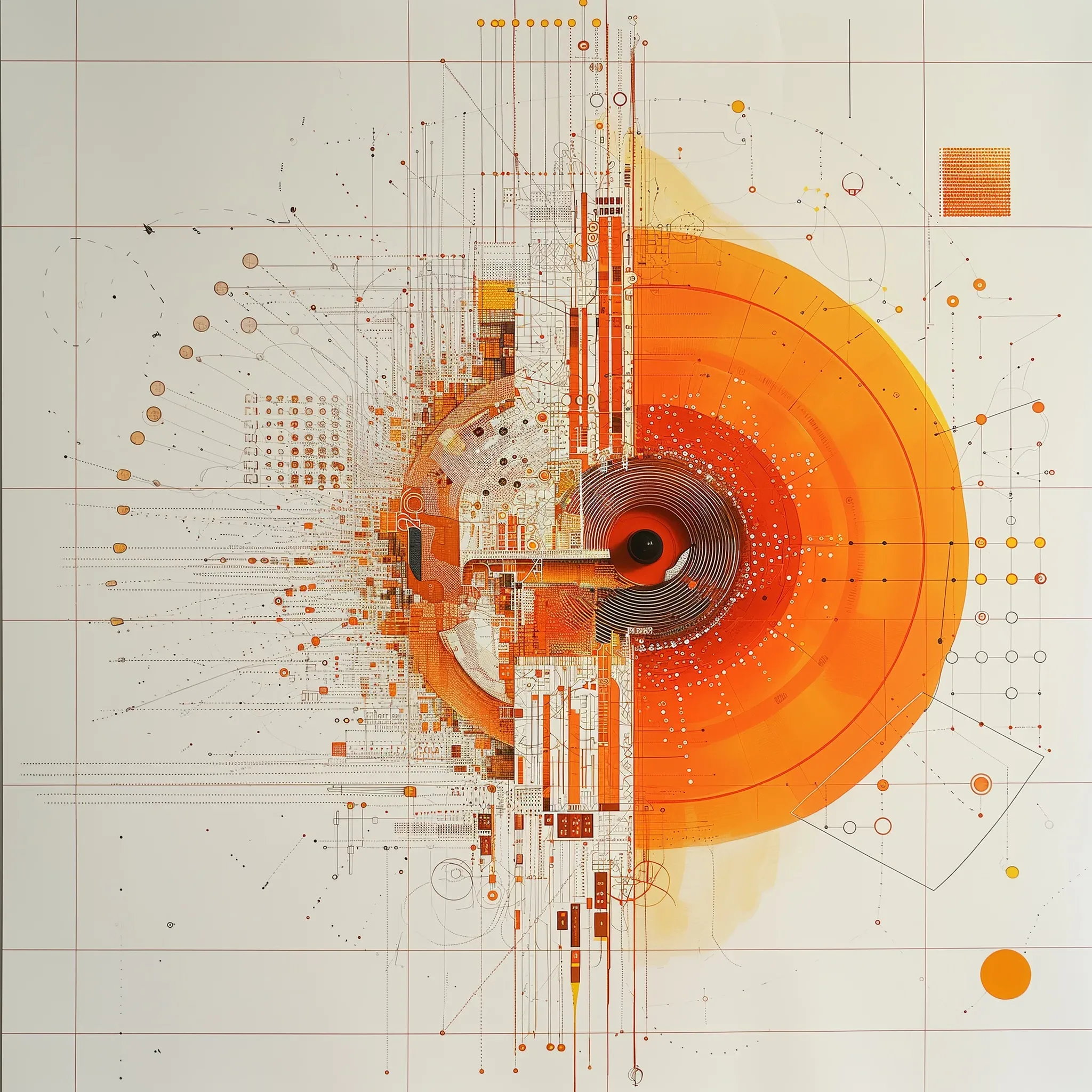Artificial Memory and Orienting Infinity
Kei Kreutler
Four hundred years before the term artificial intelligence emerged, debates about the development of “artificial memory” stirred. In contrast to the idea of natural memory, artificial memory involves using aids to help us remember. These include internal aids like memorization techniques that enrich personal memory and external aids like encyclopedias that enrich societal memory. The earliest known artificial memory includes practices like Chinese room mnemonics, associating spaces with concepts, and Australian Aboriginal songlines, associating verses with landscapes.
However, not everyone saw the development of artificial memory in a positive light. In 1530, the eclectic physician Cornelius Agrippa cautioned against it:
Artificial memory would not be able to last for the briefest second without natural memory . . . [Artificial memory], by overburdening the natural memory with innumerable images of words and things, can lead those who are not content with the limits imposed upon them by nature to the point of madness.1
Worrying about madness from the experience of “innumerable images of words and things” might evoke a sardonic laugh from anyone alive now. Media saturation is the norm, and determining the line between natural memory and artificial memory seems almost irrelevant, as articles with lines like “the internet has become the external hard drive for our memories” proliferate.2 It’s a deeply ingrained narrative. From the known invention of writing 5,000 years ago to the creation of the World Wide Web, technology has been shaping how we remember.
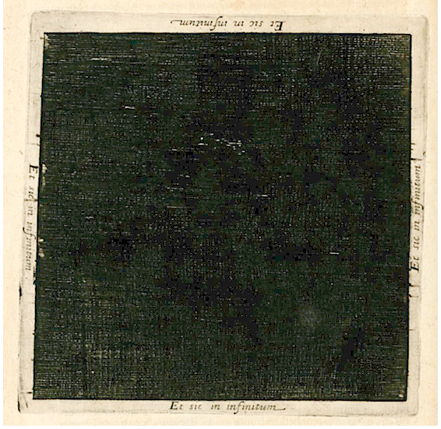
Perhaps the original, forgotten black square, with “Et sic in infinitum” (And so on to infinity) inscribed below it. Robert Fludd, Utriusque cosmi maioris scilicet et minoris metaphysica, physica atque technica historia, 1617
So what could have happened in the sixteenth century for Agrippa to feel such disdain toward it? He might have foreseen our strange historical condition, in which our actions immediately create archives. Whether buying items with a credit card, looking up directions, or sending a text, computing creates traces of intention that previously nearly vanished from record. Agrippa worried about “overburdening the natural memory,” as though he could see the limit of natural memory and its oncoming destruction through innumerable traces.
Despite Agrippa’s warning, it seems artificial memory is unavoidable and inevitable. Even the tools we make can be thought of as a type of memory. Philosopher Bernard Stiegler gives an example using the archetypal object of the anthropologist, the flint arrowhead:
When a prehistoric man cuts flint […] obviously he doesn’t cut flint to preserve his memory. But the act of cutting preserves […] his gestures on the flint, and in fact, constitutes a new memory support.3
The construction of every tool also constructs a “memory support,” not only for those using it but for following generations. Our conscious and unconscious experiences of these innumerable traces determine the paths our descendants walk. Our language tools carve the way they think, the tools they will create, passing on memory otherwise lost with our death.4 When every tool conveys artificial memory, these innumerable traces mean we live in a world made of memory all the way down.5
The shadow of technology
With memory and technology so closely woven together, each the shadow side of the other, popular understandings of memory can reveal understandings of technology.6
Today, memory can’t escape computing metaphors. Memories are read, written, and erased through the brain, which means it is more or less the world’s most complex computer in this metaphor. We equate limits of natural memory with limits of computer memory. Unsurprisingly the roots of this metaphor can be found in Agrippa’s age, and it continues today with the development of artificial intelligence. With their wholesale embrace across societies, metaphors from computing suggest that all memory can be available as data. How to navigate remembering and forgetting this data remains less clear.
Scientific literature documents the concept of threshold forgetting.7 It describes the curious effect in which individuals are much more likely to forget their intention upon crossing a threshold like a door. Most people can relate to instances of standing in the kitchen and struggling to recall their original purpose for entering. This concept can also be applied to digital spaces. Have you ever opened your phone with the intention of checking a message from a friend, only to find yourself navigating through five apps, three websites, and who knows how many advertisements, struggling to remember your original purpose? Monetized digital environments seem to intentionally prompt threshold forgetting, guiding users through a labyrinth of addictive applications—only to be lost forever, having taken the wrong route toward infinite scrolling.
The act of remembering your path through the digital labyrinth is a way of changing perception. Though we leave behind innumerable traces, it has become commonplace to forget the source, origins, or authenticity of the information we carry. This is especially true in the renaissance of spam and deep fakes driven by artificial intelligence. The strange emerging combinations of machine learning and cryptography will further force a profound renegotiation of our relationship with memory. To navigate these unusual and innumerable traces we’ll need different sensibilities.8
If we can momentarily step back from and examine the dominant worldview of memory-as-data, we can delve into what’s at stake in our popular understanding of memory. What role does memory play in shaping a world? What if preserving an archive doesn’t guarantee memory? More radically, why should humans care about remembering at all?
Orientation
To begin answering these questions, we can look to the historical development of artificial memory, starting with one of its earliest recorded protocols and ending with the invention of computers, from which the memory-as-data metaphor emerges. Building upon this backdrop, with examples from memory theaters to transistors and from shipping warehouses to community lore, the essay conjures a framework that helps us move beyond existing metaphors for memory and understand how it operates in the world.
The essay closes with the definition of orientation. The term doesn’t describe a historically new phenomenon. Instead, it elevates a nascent sensibility present throughout many different artificial memory protocols. As archives mutate and our strategies for exploring them evolve, orientation guides action in a world designed for threshold forgetting.9 It reconstructs context, and it reshapes lore. The software is not the story, but we can use it as an orientation cue.
Protocolization of memory
Distinguishing between natural memory and artificial memory isn’t straightforward. The term “memory” is defined by the Oxford dictionary as “The psychological function of preserving information, involving the processes of encoding, storage, and retrieval,” a definition nearly applicable to both human brains and computers. Neuroscience speaks in a similar vein, suggesting that we construct our memories, which “change each time they are recalled.”10 If memory is essentially a construction, then in a sense, all memory could be considered artificial. So, the distinction between natural and artificial memory doesn’t rely on the idea of authenticity.
If a distinction between natural memory and artificial memory can be made at all, it primarily revolves around the intention toward “encoding, storage, and retrieval.” Artificial memory aims beyond just the recollection of innumerable images. It also strives to enhance the organization of their “retrieval” through systematic “encoding” to better order their recollection. This implies a procedural form of remembering, akin to protocols. Instead of viewing natural and artificial memory on a spectrum of authenticity, it’s more useful to regard them as unprotocolized and protocolized approaches to memory.
Method of loci
The method of loci is an early recorded instance of such protocolization. Its origins trace back to Hellenic lyric poet Simonides around 500 B.C.E. The tale begins with Simonides reciting an epic poem at a banquet, and upon stepping outside shortly thereafter, the banquet hall collapsed, leaving the crushed guests unrecognizable. Simonides was able to identify each guest by mentally retracing his steps and recalling where each sat at the dinner table. This technique of memorization, where facts are associated with specific locations, later became known as the method of loci.
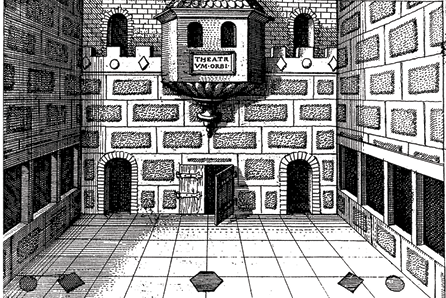
Jean Théodore de Bry, Theatrum Orbi, from Robert Fludd’s Utriusque cosmi maioris scilicet et minoris metaphysica, physica atque technica historia, 1617–1621
By the first century B.C.E., the method of loci became so popular that the orator Cicero enshrined it as one of the five canons in the rhetorical arts, alongside elements like style and delivery. Memory, now equipped with a clear procedure, could be honed. The procedure involved selecting a “formal structure,” be it a cherished church, school, or home, and within that formal structure, designating distinct “memory places.” Each of these places became repositories for “memory images.”11 For instance, if you sought to commit the planets to memory, you could summon the image of your local church, assigning each alcove within it as a memory place to house a detailed memory image of a planet, complete with its name and pertinent details. After which, you could mentally traverse the church, summoning facts tied to each planet as you pass each alcove.
The method of loci placed less emphasis on the actual existence of the chosen formal structure than on the practitioner’s ability to vividly recollect it in their imagination. It encouraged practitioners to forge unique and extraordinary connections with the experiences they memorized.12
This remarkably effective memorization technique would have thousands of pages devoted to it in the centuries that followed. Several Western philosophers from Aristotle to Aquinas would expound upon it, and predating Simonides, analogous memorization techniques also developed throughout Asia.13 In its combination of the universal and the particular through procedure, the protocolization inherent in the method of loci made it highly adaptable.
Memory theaters
In Renaissance Italy, theaters emerged as the preferred formal structure for its practitioners, and the memory theater of Giulio Camillo best illustrates this zeitgeist. The project remained more legend than fact, with only one small wooden model ever built, said to contain “many images” and rather disparagingly, be “full of little boxes.”14 Nevertheless, its grand vision could not be thwarted by the constraints of reality. The memory theater featured ascending rows corresponding to the seven visible planets and aimed to “locate and administer all human concepts, everything which exists in the whole world,” such as the natural sciences and the arts.15 While the suggestion that memory theaters administer knowledge of “the whole world” smells of hubris, their popularity signals a new perspective in artificial memory. Memory theater models explicitly combined the notion of public space, an image of the world, and a knowledge system.

Depiction of Giulio Camillo’s memory theater, Artist unknown, 1511

From the method of loci to memory theaters, these examples of artificial memory drew upon spatial metaphors, predating the computing metaphors that are prevalent today. However, these practices played a crucial role in shaping the concept of memory as something that could be “encoded” and “retrieved” through protocols. This laid the groundwork for the evolution from predominantly spatial metaphors to the prevailing understanding of memory-as-data.
Data-ification of memory
The practices discussed above, which embraced the label of “artificial memory,” might have been relegated to outdated rhetorical arts if several thinkers had not applied them to the realm of deductive reasoning. Deductive reasoning involves a systematic approach to argumentation, deriving certain conclusions from provided premises. Its origins can be traced back to the fourth century B.C.E. and in the seventeenth century it gained added significance when it began to be used as part of formal logic in mathematics.
A lingering thought leader in deductive reasoning, René Descartes couldn’t escape having an opinion on artificial memory. In his Discourse on Method, Descartes openly expressed his criticism of the popular art, recounting an incident involving an individual skilled in artificial memory who “spoke without judgment” to “explain to others what they already knew,” relying on memorization more than actual comprehension.17 Still, Descartes acknowledged insights of earlier thinkers who suggested that artificial memory could extend beyond superficial uses. For these thinkers, artificial memory took on an “ordering function,’ signifying a methodical, structured, and procedural organization of concepts.18
This protocolized approach rendered artificial memory conducive to deductive reasoning. As Descartes claimed, the “true art of memory” involves the “reduction of things to their causes.”19 In other words, the redemption of artificial memory relied on the quality of the memory images a practitioner used, which Descartes believed should represent foundational causes such as mathematical certainties, rather than snippets of trivia for rhetorical arts. By memorizing foundational causes through artificial memory, Descartes conceded, you could be better equipped to construct arguments through deductive reasoning.
Expanding the scope of artificial memory beyond rhetorical arts to establish it as a component of deductive reasoning had far-reaching consequences. This influenced the development of the scientific method through Descartes as well as thinkers like Gottfried Wilhelm Leibniz, along with the broader landscape of knowledge systems such as encyclopedias and the quest for a universal, mathematical language.20 All of which set the stage for an invention that would permanently reshape our perception of memory: the computer.
Machine searchable memory
Artificial memory turned calculation machines into modern computers. Often credited with the conceptual invention of the computer in the 1830s, Charles Babbage and Ada Lovelace theorized what would happen if a calculation machine could remember states, using the output of one operation as input for another. One hundred years later, Alan Turing furthered this line of thinking with his “automatic machines,” known now of course as Turing machines. He envisioned a machine capable of storing and reading states, then executing actions based on its present state and input. Central to this conceptualization, Turing introduced the idea of a “memory of infinite capacity,” represented by a recording tape where symbols could be read, written, and erased.21
As computing moved from theoretical concepts to tangible hardware, the introduction of transistors marked a turning point for computer memory. These tiny semiconductor devices, typically made of materials like silicon and arranged on microchips, enabled the creation of small, fast, and cost-effective computer memory storage. Earlier approaches to storage exhibited varying retrieval times due to mechanical constraints. Retrieving specific bits of information usually required moving parts in the device to find the precise location where it stored the information. The introduction of random access memory (RAM) in 1947 changed this process. RAM allowed data to be read and written in any order. While engineers initially used other substrates (such as magnetic core grids) for RAM, semiconductor memory made it a global reality and remains in use for most variations of RAM today.
With this sequence of technological shifts, and associated theoretical advances such as information theory, our perception and experience of memory changed.22 Computer memory became colloquially equated with memory writ large, portraying the world as information to be encoded, stored, and retrieved.
Specifically, the capability to read and write data in any order impacted the utility of artificial memory. As knowledge systems expanded in size over previous centuries, they leaned on the expansion of taxonomic arrangement to index “all human concepts.” Previously the failure of retrieval processes to scale proportionately hindered the vision of an externalized “memory of infinite capacity.” What value would there be in having “all human concepts” meticulously organized if you had to navigate item by item to locate the desired information? Alphabetical, index-based, and concept-driven categorizations could only extend their utility to a certain extent. Just imagine the World Wide Web without a search engine, necessitating a byte-by-byte serial journey to get to any destination.
It’s worth recalling memory theaters, which aspired to “locate and administer all human concepts, everything which exists in the whole world.” This ambition resonates with the notion that constructing a sufficiently complex model of the Earth would demand more computational resources than the planet itself could offer.23 Ultimately for computer memory to approach infinite capacity, its retrieval had to move away from sequential processes and towards increasingly sophisticated search algorithms operating on machine-readable higher-dimensional interconnected forms.
While all technology functions as “memory supports” through storage, machines were now capable of going one louder, actually performing the aim of artificial memory to not only store but to better order recollection.24
Latent and living memory
The advances in computing firmly established the now pervasive metaphor of memory-as-data. Exploring the historical development of artificial memory, however, it becomes clear we still live within this unfolding narrative. Singling out the memory-as-data metaphor doesn’t imply that technological changes haven’t positively contributed to our comprehension of memory. Far from it. It just prompts us to pause, reflecting on the rapid and widespread adoption of this metaphor across societies. This reflection especially gains significance when considering that some anthropologists advocate important societal knowledge endures most dependably through oral transmission.25
The archive preserved through computer memory expands, but is it memory? Does computer memory function akin to societal, personal, or even ecological memory? It could prove more generative to evaluate memory not within the confines of artificial or natural, computer or human, but to conjure a framework that describes how memory operates within the world, beyond its storage format.
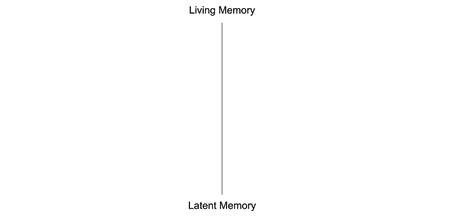
Latent memory vs. living memory
We can differentiate between memory stored within an archive and memory that involves engagement, exploration, and retrieval from that archive. These two types can be described as latent memory and living memory, respectively. Latent memory refers to experiences that have the potential to be recalled and shared. On the other hand, living memory refers to experiences in the process of being recalled and shared. Latent memory can be accessed, but it’s living memory that is actively transmitted.
Memory databases
We can observe an illustrative tension between latent memory and living memory in approaches to preserving societal knowledge today: well-funded institutional endeavors to digitize knowledge.
As an example, the Museum für Naturkunde Berlin unveiled the Data Portal in 2021, housing over 40,000 entries with taxonomic information. The museum envisions the Data Portal as global research infrastructure that will eventually offer some level of access to its collection of 30 million objects. As the Museum für Naturkunde Berlin undertakes the task of 3D scanning insects from their collection, a fundamental question persists: how will these memory databases come to life? Who assumes the role of custodians, serving as guides for the solitary researcher who seeks information about an obscure scarab beetle in the depths of the night?
The Museum für Naturkunde Berlin, however, takes steps to ensure latent memory becomes living memory. A majority of their staff consists of researchers, whose work transmits knowledge over time and for whom the Data Portal undeniably serves as a vital resource.
However, for many initiatives aiming to digitize knowledge, this level of dedicated attention to their archive might not be available. Memory databases share a similar goal with memory theaters of the past, aspiring to “locate and administer” a knowledge system. Though Camillo’s memory theater involved feedback between a private memorization technique and a public theater, memory databases present themselves for public consumption with limited feedback mechanisms. The latent memory they store can be accessed and shared, but they often lack the cultural practices necessary to encourage their transmission as living memory.
It’s conceivable that we might find ourselves in a world where societal knowledge stored within archives, essentially latent memory, slowly fades into obscurity, partially forgotten. Deriving directly from the memory-as-data metaphor, this could arise from our tendency to view memory as something that needs storage rather than transmission in order to endure.
The tendency described does not belong to scientific museums alone. It reflects a broader trend symptomatic of the memory-as-data metaphor. In the societal pursuit of infinite latent memory, the attention given to living memory wanes. It’s living memory, however, that enacts worlds which live and die by attention.26
Memory landscapes
Living memory is closely linked with lore, the stories cultures carry. Like lore, living memory evolves in relationship with humans, landscapes, and agents, and living memory must be enacted in time. Living memory is about the interruption in the archive—the incision in the flint arrowhead, the recollection that alters a memory but assures its transmission.27 Often reliant on but not reducible to data, living memory distinguishes itself from latent memory.
You might assume that oral transmission’s ability to preserve societal knowledge stems from its minimal reliance on externalized latent memory. With a smaller recorded archive, it might have a diminished risk of confusing the archive with the act of transmission and thereby neglecting the latter. Latent memory doesn’t always look like an archive, however.
Examples of different latent memory can be found in the work of Lynne Kelly, author of The Memory Code, who studies cross-cultural memorization techniques. Originally setting out to explore animal behavior and Australian Aboriginal stories, Kelly’s research changed course after discussions with elders revealed their knowledge of animal behavior far exceeded the insights of any field guide she had encountered. In her work, Kelly shares stories about songlines, which can be described as short, sung verses that correspond to features in a landscape, such as mountains, springs, and outcrops, visited in a fixed order along a path.28 While this process could pass down similar knowledge as stored in memory databases, this artificial memory operates differently in the world. Of course, how a culture acquires knowledge shapes their relationship to it.
The Anangu, an Aboriginal group and traditional owners of the Uluru sandstone monolith in Australia, describe their knowledge system Tjukurpa surrounding it to include
[T]he law for caring for each other and Country, the relationship between people, plants, and animals, and the physical features of the land, the past, the present, and the future.29
Generations of memory accompany Uluru’s perimeter, but as Kelly notes, its memory landscape has been so internalized, Anagu knowledge specialists do not need to be walking its perimeter to recall their stories.
Through aids like songlines and Tjukurpa, groups come to know “innumerable images of words and things” about their orientation in place and time. Belying Agrippa’s assumption that artificial memory leads to madness, they deepen the quality of memories without overtly constraining their quantity.
Songlines and other practices make latent memory in the landscape living memory through a process of transmission and renewal. In this context, the landscape doesn’t represent societal knowledge, so much as it produces living memory through a relationship with its inhabitants. This stands in stark contrast to the memory-as-data metaphor, which tends to imply that knowledge exists relatively self-contained within its storage format. Whereas in songlines, the artificial memory lives relationally between mediums, between landscapes and their inhabitants, rather than within a medium like discrete data alone.
This is an important insight for internet-native organizations, which increasingly favor “lore” as a term for describing the remembered stories that digital spaces tell about themselves, as it connects these new spaces to older forms of campfire gatherings and flint arrowheads.30, 31 But its use runs the risk of mistaking innumerable traces of digital spaces for living memory for what makes worlds alive.32
Simply producing an archive that anyone can build on doesn’t open a world to aliveness. It’s the relationship between the archive and its participants, the data and its transmission, and the latent and living memory, that ensures lore continues in time. Mediums of memory play a key role in how it operates in the world.
Taxonomic and associative arrangement
Having differentiated between latent and living memory, we can also distinguish between ordering principles in memory. Among the examples explored so far, some adopt a taxonomic approach encountered in formats like encyclopedias and the Data Portal discussed above. Taxonomic knowledge systems operate on the premise of clearly defined and standardized relationships among the entities they encompass. This is evident in scientific classifications that categorize organisms into distinct genus and species. A significant portion of conventional education revolves around imparting taxonomic knowledge systems to students, including tasks like memorizing the five kingdoms of biological life.
Today we place less emphasis on this type of rote memorization, at least as adults. We search for something, rather than remember it. Our phones surface memories for us. The notion referenced above that the internet could function as a “hard drive for our memories” highlights the extent to which we rely on technology as an external aid. The proliferation of latent memory in the digital realm has changed our relationship with living memory. What was once an internal process, akin to a memory palace, may now be easily externalized for all to access as virtual architecture. The task of artificial memory to better order recollection can now be enhanced by machines.
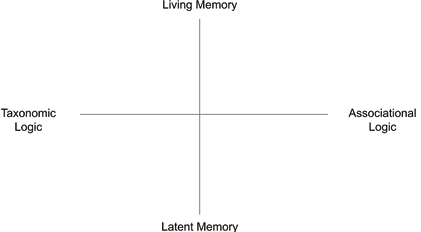
Memory and taxoniomic regimes
Taxonomic knowledge systems serve not only as a means of classification but also as a method of human-readable organization. Previously, if you were seeking information about a particular branch of philosophy, you might start by specifying the time period, then delve into its geographical context, and so forth. You might have physically searched through filing cabinets organized from the broadest categories to the most specific until you found what you needed.
Now, you think of a philosophical vibe and with a keyword or two, you enter something like it into the search bar. Changes in how we retrieve latent memory diminish the visibility of human-readable organization. Before we even access it, human-defined categories and machine-driven sorting arrange latent memory, fundamentally altering the way we navigate it. We glide over the surface of latent memory, forging associations between concepts more than classifying them. How this memory operates in the world begins to look more like the practices of songlines and less like entries in a memory database.
Respatialization of memory
Instances of associative arrangement prevailing over taxonomic extend beyond the confines of digital spaces, even reaching into the domain of shipping warehouses. Traditionally, shipping warehouses organized items of the same category together, such as positioning toothbrushes next to toothpaste. A new method dubbed “chaotic storage” involves placing items wherever there’s available space, without adhering to strict categorization.33

View of Amazon warehouse in Spain (cropped from original by Álvaro Ibáñez, CC BY 2.0)
This method arose from the insight that having, for example, toothbrushes distributed throughout the warehouse would increase the likelihood that a staff member or robot might be near a toothbrush at the moment an order came in for one, initiating the shipping process sooner. Driven by speed, capital, and technology, chaotic storage downplays the significance of human-readable ordering principles, like neatly arranged shelves with specific categories. Instead, it leverages item tracking to align with associative arrangement.
Latent memory seems to preemptively handle the organization of physical, digital, and remembered items for us. New technology reinforces our tendency toward an associative view of the world over a taxonomic one, even though the ordering principles of this technology are—for now—inherited from human perspectives.
But this isn’t entirely new. Certain practices of artificial memory display associative over taxonomic arrangement. Returning to Lynne Kelly’s book The Memory Code, she writes about a particularly striking case coming from the Luba empire, where court historians known as bana balute, “men of memory,” would be aided by a lukasa memory board.34 While reciting epics, genealogies, and migration routes, they would run their fingers over the lukasa’s unique features. Clusters of lines on the board often denote migration routes, and a red bead commonly portrayed an anti-hero, a rainbow serpent, from well-known Luba epics. Unlike more figurative representations, lukasa are rooted in associative arrangement. The red bead doesn’t try to represent the rainbow serpent, instead the red bead becomes the rainbow serpent through association, not unlike how songlines produce memory with the landscape and its inhabitants.
Associative arrangement suggests connections between previously non-contiguous and asynchronous pieces of information. In his memoir, Charles Babbage professes his work collapses “space into time,” and the widespread use of networked technology, such as video conferencing, has turned this idea into an everyday reality.35 However, a new phenomenon might be underway: a respatialization where the logic that collapsed space into time now remaps a logic of its own onto space.36 In chaotic storage, items like toothbrushes and satellite radios might be placed together not due to human-readable categories, but because they belong to the same category in time. Through the ordering principles of associative arrangement, the map does not even pretend to be territory. Instead, it creates a new territory through the power of association alone.
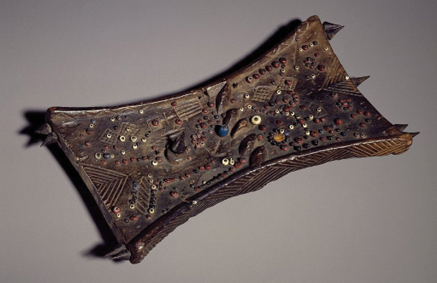
Lukasa memory board, late nineteenth or early twentieth century (Brooklyn Museum collection, CC BY 3.0)
More often than not, artificial memory blends taxonomic and associative arrangement, with individuals typically experiencing only certain aspects of each. A taxonomic memory database informs associations for a researcher. A landscape, like the latent memory within songlines, transmits its own living memory. These distinctions depend on your perspective and location within an artificial memory protocol.
The framework sketched above tries to offer a deepened sensibility around how memory operates in the world, and create some distance between ourselves and the increasingly ubiquitous memory-as-data metaphor. The sensibility is not about searching for morally superior forms of artificial memory. These examples, from shipping warehouses to lukasa boards and from songlines to search engines, share odd resemblances and obvious differences, and do not suggest any obvious value judgments. Rather, the sensibility is about appreciating how artificial memory protocols that embrace associative arrangement offer insights for orientation.
Sensing and orientation
Polynesian cultures are known for their traditional methods of wave navigation. Traditional polynesian navigators can set out from one island, without a map, instruments, or land visible on the horizon, and arrive at another. This ability in part relies on a form of artificial memory. In the Marshall Islands or the Aolepan Aorokin Majel, they refer to navigators as ri-meto and the charts they create as meto. Made from coconut sticks and stones, meto do not represent landmasses statically on an immovable sea from a uniform perspective. Instead, they craft a representation of the sea at one moment in time from the perspective of the navigator. These charts account for the shape of waves and the direction of wind, knowing that distant and unseen landmasses shape both elements. For example, “If the rilib [a strong East to West swell] is on the left side of the boat, and they cross a kaelib [a West to East swell that only appears during part of the year] from the right side of the boat, they know they are north of an island heading south.”37 These signals combined with others, like birds above, provide the navigator with an orientation in place and time.
Before initiating any change in course, the navigator points toward their starting point and only after turns the boat. This practice ensures the navigator maintains constant awareness of their initial orientation. Meto artificial memory demonstrates remembering how, rather than remembering where.
Defining orientation
As living memory increasingly embraces associative arrangement, artificial memory’s primary focus turns towards orientation.
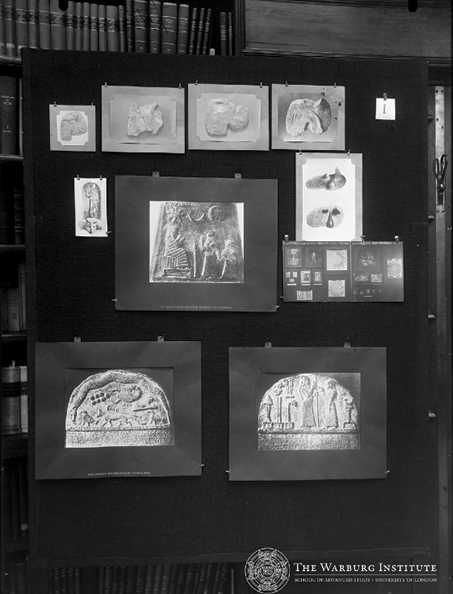
Aby Warburg, Bilderatlas Mnemosyne, Panel 1, 1929
A nascent sensibility defined here, orientation can be understood as a form of situational awareness that arranges knowledge in a selective and associative manner aligned with a particular purpose. Orientation enables navigation based on partial cues, feelings, and hints within an environment, without presuming complete situational awareness. This environment might be characterized by spatial non-contiguity and temporal asynchrony in relation to the participant, and the associations themselves can also be noncontiguous and asynchronous. These associations do not need pre-established relationships, as though unveiled through scientific classification. Instead, orientation generates connections between the elements it associates.
We can find a glimpse of this abstract idea in the work of Aby Warburg, an art historian from the early twentieth century. His work the Bilderatlas Mnemosyne, named after the Greek goddess of memory and mother to the muses, comprises 61 panels featuring nearly 1,000 images ranging from antiquity to twentieth century culture. Each panel assembles images around a thematic focus, such as “Coordinates of Memory,” “Dionysiac Formulae of Emotions,” and “Archaeological Models.” Warburg establishes connections between the images included based on unconventional, symbolic resemblances. In the introductory notes for Bilderatlas Mnemosyne and other writings, he emphasizes the practice of Orientierung (orientation) through the concept of Pathosformel, a term he coined to describe recurring “emotionally charged visual tropes” in art.38, 39
Orientation here demonstrates a universal procedure for particular experiential arrangement. Warburg’s search for recurring visual tropes follows neither the chronological nor geographical logic of most art historical ordering principles. It yields highly idiosyncratic and syncretic results with an orientation toward a particular direction: historically irrational resemblances in images across place and time. While difficult to situate within traditional art history, Warburg’s practice clearly anticipates internet culture’s relationship to images, from platforms like Tumblr to message boards.
Reconstructing context
Orientation surfaces retrospective associations as much as prospective ones. It looks back in time as much as it shapes the future. The endeavors of artificial memory practitioner Giordano Bruno hold great significance in this context.
A defrocked monk, his heretical ideas included considering the universe infinite and the earth not at the center of it. Much of his work dealt in memory. Bruno frequently used memory wheels, which are illustrative diagrams with movable, concentric circles originally devised by a scholar in the thirteenth century. They can be used to detail concepts related to a broader philosophical, religious, or moral framework. Through turning the wheels, different concepts combine to produce different thoughts for contemplation.40
In her seminal book The Art of Memory, the scholar Frances Yates narrates texts in which Bruno compiles lists of memory images, focusing on his joyfully enigmatically titled book De umbrias ideareum or On the Shadows of Ideas. Yates takes the liberty of arranging memory images from this book on a memory wheel, as Bruno did in many instances of his work. Yates places astronomical images on the innermost circles, with human images on the outermost circle. This results in, for example, the potential pairing of Saturnian attributes with Ceres, the inventor of yoke for oxen.41
As you turn the wheels, you confront associations between human and planetary narratives. This is an act of orientation on behalf of Bruno but also on behalf of Yates, in which she uses her expertise to surface inherent relationships she sees in his work.
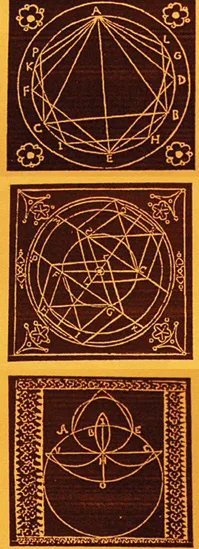
Giordano Bruno, memory seals, 1588
Yates illuminates how Bruno’s philosophy operated through his memorization techniques. Grounded in the phrase “as above, so below,” Bruno emphasizes the relationship between humankind and the cosmos, the reflection of both in each.
Bruno’s own books consistently echoed these themes. In some instances, he expanded upon memory wheels, going so far as to create abstract diagrams for memory places and memory images, as in the image below. This memorization technique involved internalizing the diagram, associating various concepts with different segments of the diagram, and recognizing connections between these concepts.
However, Bruno didn’t develop memorization techniques merely as contributions to the rhetorical arts. He asserted that universal procedures for particular experiential recollection—artificial memory protocols—are procedures to reshape consciousness. His diagrams didn’t just signify a connection between humankind and the cosmos, they intended to produce it through contemplation. What might appear as abstract esotericism in Bruno’s work closely resembles the maxim of media scholar Marshall McLuhan: “The medium is the message.” Put in everyday terms and ripping off classic dietary advice, you are what you remember. As noted by Frances Yates,
These pages of Bruno’s are a kind of manifesto of the primacy of the imagination in the cognitive process which he refuses to see as divided among many faculties but as all one.42
He saw memory as a fundamental element of consciousness, echoing thinkers like the eleventh century physician and philosopher Avicenna, who advocated for a therapeutic exploration of memory.43
By viewing orientation as a sensibility, a method for navigating memory, we can preserve its therapeutic and medicinal potential, using it to reconstruct context that might otherwise be lost amid innumerable images.44 On one hand, Bruno’s approach to orientation resembles hopeful delusion, suggesting that belief begets truth. On the other hand, it signifies recognition of agency.
Despite its often involuntary nature, intentionally cultivating memory through orientation can reshape consciousness. After all, even our thoughts about the future are themselves memories.
————
Could it be that we finally reached Agrippa’s true cause for concern about artificial memory? Unlike natural memory, artificial memory protocols involve the invention of new devices like lukasa boards, imagined theaters, and memory wheels. These devices sever knowledge from its original context and remold it into a different form. Agrippa may have been cautious about artificial memory because of the psychological risks posed by such total recontextualization and transformation.
In an age that foists innumerable images upon us, we don’t always have a choice to preserve the context of our encounters. Considering the central role of living memory in shaping our understanding of the world and enacting its aliveness, intentionally cultivating memory may be worth the risks. Examples like songlines and Tjukurpa demonstrate that reconstructing context can still be achieved in relationship with ecological memory.
Rather than fantasizing about a return to a pre-digital era of orality, the sensibility of orientation elevates a throughline of associative arrangement in the history of artificial memory. An active process of orientation allows us to trace a path through latent memory towards the transmission of living memory. It’s akin to leaving a trail of string behind, enabling us to remember our steps across various thresholds and reconstruct context. The sensibility of orientation guides action in a world designed for threshold forgetting.
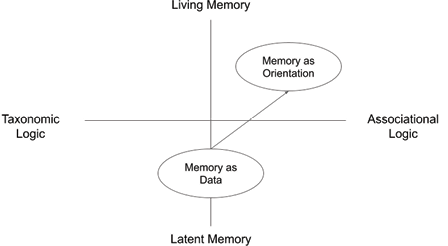
Moving memory from data to orientation
It bears repeating that strange combinations of machine learning and cryptography will further force a profound renegotiation of our relationship with memory.45, 46 Still, a more radical question remains. Why should humans care about remembering at all? Since machines can perform the aim of artificial memory, it may be appropriate to interrogate the role of human consciousness. In certain science fiction scenarios, it’s conceivable that machine latent memory could create its own version of living memory, much like the claim that artificial intelligence is already devising its own languages.47
This prompts the inquiry: is it necessary for living memory to be transmitted between living beings in order to endure? Does living memory require what we might recognize as consciousness? Or could living memory exist between mediums and between agents, a type of unconscious and impersonal historical force?
In our everyday lives, one response could be to embrace orientation, more consciously constructing associative living memory in collaboration with machines, much as we do with landscapes. This would involve reshaping our senses in light of these technological changes and abandoning the longstanding taxonomic distinction between the artificial and the natural.
This essay is a prelude to the forthcoming book Artificial Memory which analyzes nascent technologies such as programmable cryptography, large language models, and even climate models alongside global historical practices through these remaining questions. Framing these remaining questions, this essay is intended to serve as orientation, conjuring a framework that helps us move beyond existing metaphors for memory and understand how it operates in the world.
Artificial memory ultimately provides a way of seeing technology; orientation helps us read the wind and waves to understand how the coming experience of infinity, Agrippa’s “innumerable images of words and things,” might feel. Δ
Acknowledgements Thanks to Aaron Z. Lewis, Venkatesh Rao, Scott Moore, Alice Noujaim, Chenoe Hart, and Ben Vickers for their invaluable feedback on this essay. Thanks to the New Time Machines Working Group who approved this essay. The Ethereum Foundation’s Summer of Protocols research program supported this research, and its gracious intellectual environment enabled this essay to grow into the prelude to an early stage book. Many thanks to them. Final thanks to the Biblioteca Nazionale Marciana in Venice, Italy, where San Marco’s lion looks kindly upon the arts of memory.
Kei Kreutler is a writer and artist interested in how cultural narratives of technologies shape their use. Previously, she co-created Gnosis Guild, a small team behind the Zodiac open software standard for interoperable, modular governance tools. Currently she is developing a book project on memory as a way of seeing technology, economics, and ecology. To follow the progress of the book, subscribe at keikreutler.substack.com.
website: www.ourmachine.net
Bibliography
“Amazon—Leading the Way through Chaos,” SSI SCHÄFER Blog, April 20, 2012. web.archive.org/web/20120420040000/http://www.ssi-schaefer.de/blog/en/order-picking/chaotic-storage-amazon/.
Becker, Colleen. “‘Aby Warburg’s Pathosformel as Methodological Paradigm.’” Journal of Art Historiography 9 (December 1, 2013): 9-CB1. arthistoriography.files.wordpress.com/2013/12/becker.pdf.
Bishop, Ryan, and Daniel Ross. “Technics, Time and the Internation: Bernard Stiegler’s Though—A Dialogue with Daniel Ross.” Theory, Culture & Society 38, no. 4 (July 2021): 111–33. doi.org/10.1177/0263276421990435.
Borg, Jemma. Wilder. Liverpool: Liverpool University Press, 2022.
Borges, Jorge Luis, and Andrew Hurley. Collected Fictions. Penguin Classics Deluxe Edition. New York, NY: Penguin Books, 1998.
Broad Institute. “How a Mother’s Microbiome Helps Shape Her Baby’s Development,” December 22, 2022. www.broadinstitute.org/news/how-mothers-microbiome-helps-shape-her-babys-development
Ceruzzi, Paul E. Computing: A Concise History. The MIT Press Essential Knowledge Series. Cambridge, Mass.: MIT Press, 2012.
Dobrin, Arthur. “Your Memory Isn’t What You Think It Is,” Psychology Today. Accessed September 1, 2023. www.psychologytoday.com/intl/blog/am-i-right/201307/your-memory-isnt-what-you-think-it-is
Fabrizi, Mariabruna. “Spatializing Knowledge: Giulio Camillo’s Theatre of Memory (1519-1544) – SOCKS,” March 3, 2019. socks-studio.com/2019/03/03/spatializing-knowledge-giulio-camillos-theatre-of-memory-1519-1544/, https://socks-studio.com/2019/03/03/spatializing-knowledge-giulio-camillos-theatre-of-memory-1519-1544/
Friend, Sarah. “Good Death.” Summer of Protocols (blog), n.d. Pending.
Hart, Chenoe. “Addressable Space.” Summer of Protocols (blog), n.d. Pending.
Johnson, Christopher D. Memory, Metaphor, and Aby Warburg’s Atlas of Images. Signale: Modern German Letters, Cultures, and Thought. Ithaca, N.Y: Cornell University Press: Cornell University Library, 2012.
Joyce, Rosemary A. The Future of Nuclear Waste: What Art and Archaeology Can Tell Us about Securing the World’s Most Hazardous Material. New York, NY: Oxford University Press, 2020.
Kelly, Lynne. The Memory Code: Unlocking the Secrets of the Lives of the Ancients and the Power of the Human Mind. London: Atlantic Books, 2017.
LaFrance, Adrienne. “An Artificial Intelligence Developed Its Own Non-Human Language.” The Atlantic, June 15, 2017. www.theatlantic.com/technology/archive/2017/06/artificial-intelligence-develops-its-own-non-human-language/530436/
“Latent Space.” In Wikipedia, August 30, 2023. en.wikipedia.org/w/index.php?title=Latent_space
Loon, Elise Van. Waiting for the East Wind: An Analysis of Marshallese Stick Charts and Their Connection to Maritime Space. Elise Van Loon, n.d.
McLuhan, Marshall. Understanding Media: The Extensions of Man. Repr. Routledge Classics. London: Routledge, 2010.
Milne, Alasdair, dmstfctn, and Eva Jäger. “Large Lore Models.” Autonomous Worlds (blog), n.d. aw.network/posts/large-lore-models
Museum für Naturkunde. “Datenportal.” Accessed September 2, 2023. www.museumfuernaturkunde.berlin/de/wissenschaft/datenportal
Priani, Ernesto. “Ramon Llull.” In The Stanford Encyclopedia of Philosophy, edited by Edward N. Zalta, Spring 2021. Metaphysics Research Lab, Stanford University, 2021. plato.stanford.edu/archives/spr2021/entries/llull/
Proust, Marcel. Remembrance of Things Past. 1st Vintage Books ed. New York: Vintage Books, 1982.
Radvansky, Gabriel A., and David E. Copeland. “Walking through Doorways Causes Forgetting: Situation Models and Experienced Space.” Memory & Cognition 34, no. 5 (July 1, 2006): 1150–56. doi.org/10.3758/BF03193261
Rao, Venkatesh. “Lands of Lorecraft.” Accessed September 1, 2023. studio.ribbonfarm.com/p/lands-of-lorecraft
Rossi, Paolo. Logic and the Art of Memory: The Quest for a Universal Language. Athlone Contemporary European Thinkers. London New York: Continuum, 2006.
The Ister. Icarus Films, 2004. vimeo.com/ondemand/theister
Van Loon, Elise. “Waiting for the East Wind: An Analysis of Marshallese Stick Charts and Their Connection to Maritime Space.” University of Southampton, 2021.
Ward, Daniel M. Wegner, Adrian F. “The Internet Has Become the External Hard Drive for Our Memories.” Scientific American. Accessed September 1, 2023. doi.org/10.1038/scientificamerican1213-58
Yates, Frances A. The Art of Memory. Repr. London: The Bodley Head, 2014.
1. Rossi, Logic and the Art of Memory, p. 67.
2. Ward, “The Internet Has Become the External Hard Drive for Our Memories.”
3. The Ister (Icarus Films, 2004).
4. Studies show epigenetic memory endures increasingly longer than we think, with gut bacteria passed from mother to child in a chimera-like fashion during pregnancy and even potentially during the child’s first year of life. Broad Institute, “How a Mother’s Microbiome Helps Shape Her Baby’s Development.”
5. Tools not only mirror our understanding of the world, but also influence it in return. Across eras, societies, and individuals, images of the world become compressed into tools. In Agrippa’s age, history tells us modernity was not yet born. The dominant culture believed in a finite universe, and it would take those who believed in an infinite universe like artificial memory practitioner Giordano Bruno burning at the stake to suggest otherwise. A finite world stood on the precipice of infinity, desperately trying not to look down. This belief in finitude could have led Agrippa to believe that natural memory, our image of the world, had its limits too. Far from a conservative thinker, however, Agrippa stands as a useful foil in our exploration because it seems something more curious underlies his assumption that too many images of words and things could overwhelm the natural memory. Ultimately many cultures before and after Agrippa’s had their own relationship to infinity. It would be unrealistic to believe that we no longer live in an age of uncertainty, that we leapt off the precipice of wrong belief and arrived at the bottom intact, with finally, totally correct belief. The abyss is the abyss because it has no other side.
6. Memory acts as a portal through which we can begin to guess at the limits of our image of the world.
7. Radvansky and Copeland, “Walking through Doorways Causes Forgetting.”
8. “If men were able to be convinced that art is precise advance knowledge of how to cope with the psychic and social consequences of the next technology, would they all become artists? Or would they begin a careful translation of new art forms into social navigation charts? I am curious to know what would happen if art were suddenly seen for what it is, namely, exact information of how to rearrange one’s psyche in order to anticipate the next blow from our own extended faculties.” McLuhan, Understanding Media, p. 14.
9. Military strategist and pilot John Boyd developed the OODA loop, the observe-orient-decide-act loop, as an operational framework for changing environments, environments where we otherwise might be quick to forget. Within this loop, the second step, “orient,” encompasses the complex interaction between cultural traditions, genetic heritage, previous experiences, new information, and the processes of analysis and synthesis. In essence, it involves the construction of memory, so that one may decide and then act.
10. Arthur Dobrin, “Your Memory Isn’t What You Think It Is,” Psychology Today, accessed September 1, 2023.
11. Rosii, Logic and the Art of Memory, p. 19.
12. The stress on crafting imaginative, extraordinary, and marvelous memory images would continue throughout its popularity. It’s more than coincidental that the origin story of such an enduring memorization technique had its own miraculous and grotesque tones.
13. The forthcoming book Artificial Memory attempts to survey globally diverse historical practices related to artificial memory, which are frequently treated in isolation. For the purpose of the essay, earlier traditions explicitly embracing the label of “artificial memory” were chosen to limit scope.
14. Yates, The Art of Memory, p. 136.
15. Fabrizi, “Spatializing Knowledge.”
16. An artificial memory protocol could be defined as a universal procedure for a particular experiential recollection.
17. Rossi, Logic and the Art of Memory, p. 104.
18. Ibid., p. 101.
19. Ibid., p. 112.
20. Ibid. While out of scope for the essay, Logic and the Art of Memory follows this historical arc in depth and the author Rossi constructs a clear throughline from artificial memory to scientific reasoning in the work of Gottfried Wilhelm Leibniz and others (New York: Bloomsbury Publishing, 2006).
21. Ceruzzi, Computing, p. 32. Other advances in computer memory include the stored program principle and Von Neumann computer architecture.
22. In the 1940s, information theory also gained widespread recognition. Integral to the development of communication networks, information theory measures information as the reduction of uncertainty or surprise in communication. Adding to the confluence of paradigmatic shifts, it showed how language, data, and even natural phenomena could be interpreted and processed as information.
23. Borges, “On Exactitude in Science.”
24. While out of scope for the essay, the research question remains of whether multispecies artificial memory may have also performed some aspect of the capability to better order recollection.
25. Joyce, The Future of Nuclear Waste.
26. Friend, “Good Death.”
27. Philosopher Francis Bacon wrote a curious passage on artificial memory and infinity, uncannily and unknowingly helpful now: A true “memory art may properly be called the interruption of infinity. For when we try to recollect or remember something, if we have no prenotion or perception of what we are seeking, we seek and toil and wander aimlessly, as if in infinite space. Whereas, if we have a particular prenotion, infinity is at once interrupted, and the memory has a more restricted space to range over.” Artificial memory isn’t an endless archive but a deliberate interruption within it. It is a “prenotion” for particular experiential recollection. Without this, we find ourselves “wandering aimlessly.” Rossi, Logic and the Art of Memory, 110.
28. Kelly, The Memory Code, p. 13.
29. Ibid., p. 16.
30. Rao, “Lands of Lorecraft.”
31. Milne, dmstfctn, and Jäger, “Large Lore Models.”
32. Friend, “Good Death.”
33. “Amazon—Leading the Way through Chaos,” SSI SCHÄFER Blog.
34. Kelly, The Memory Code, p. 44.
35. Ceruzzi, Computing, p. 33.
36. Hart, “Addressable Space.”
37. Van Loon, “Waiting for the East Wind: An Analysis of Marshallese Stick Charts and Their Connection to Maritime Space,” p. 77.
38. Johnson, Memory, Metaphor, and Aby Warburg’s Atlas of Images, p. 22.
39. Becker, “‘Aby Warburg’s Pathosformel as Methodological Paradigm,’” p. 1.
40. Priani, “Ramon Llull.” During the thirteenth century, theologian Ramon Llull introduced his Ars, later known as the combinatory arts, and within it, he devised memory wheels. For instance, one memory wheel by Llull listed the Dignities, such as Goodness, Wisdom, Glory, and Simplicity, among others.
41. Yates, The Art of Memory, p. 215.
42. Yates, The Art of Memory, p. 251.
43. “We find a little of everything in our memory; it is a sort of pharmacy, a sort of chemical laboratory, in which our groping hand may come to rest now on a sedative drug, now on a dangerous poison.” Proust, “The Captive,” Remembrance of Things Past.
44. Popular books like The Body Keeps the Score by Bessel van der Kolk suggest that trauma endures as epigenetic and genetic memory. Contemporary therapeutic regimes also acknowledge this, aiming to change our relationship to emotional memories, and methods like eye movement desensitization and reprocessing (EMDR) therapy even attempt to reshape them.
45. “Latent Space.”
46. From one perspective, it’s ironic that a technology responsible for creating innumerable traces like blockchain protocols, which generate records for every transaction, also stands as the most promising means to cryptographically verify the authenticity of information.
47. LaFrance, “An Artificial Intelligence Developed Its Own Non-Human Language.”
© 2023 Ethereum Foundation. All contributions are the property of their respective authors and are used by Ethereum Foundation under license. All contributions are licensed by their respective authors under CC BY-NC 4.0. After 2026-12-13, all contributions will be licensed by their respective authors under CC BY 4.0. Learn more at: summerofprotocols.com/ccplus-license-2023
Summer of Protocols :: summerofprotocols.com
ISBN-13: 978-1-962872-06-5 print
ISBN-13: 978-1-962872-32-4 epub
Printed in the United States of America
Printing history: February 2024
Inquiries :: hello@summerofprotocols.com
Cover illustration by Midjourney :: prompt engineering by Josh Davis
«artificial memory, orienting infinity, exploded technical diagram, orange»
